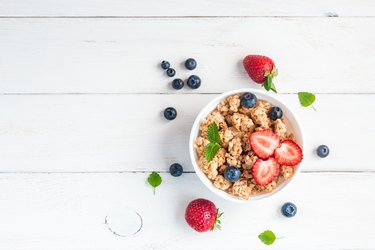
When you eat more frequent, smaller meals, you may find it easier to manage your weight and energy levels. Breaking your food intake up into six meals a day isn't difficult as long as you plan things ahead and make sure you meet your nutritional needs.
Why Six Meals a Day?
Video of the Day
Eating six meals a day may improve appetite control and blood sugar levels. According to a small study presented at the September 2017 annual meeting of the European Association for the Study of Diabetes, a six-meal diet has been shown effective at controlling blood sugar in people with obesity who had prediabetes or type II diabetes.
Video of the Day
In the study, half of the 47 participants with obesity who had diabetes or prediabetes followed a special diet for six months that had them eat six smaller meals per day for three months and transitioned to three standard-sized meals a day for another three months. The other half of the participants started with the three standard-sized meals for three months and switched to six small meals per day for the last three months.
The six-meal diet group had significantly better blood sugar control compared to those eating three meals per day. Therefore, frequent, small meals consisting of roughly the same number of calories consumed at regular intervals may help you be more successful at dieting. More research is needed to confirm these findings, though.
You're better able to avoid binges and poor meal choices when you eat frequently. You never hit that starving feeling where you eat anything and everything just to fill your belly. Plus, your blood sugar doesn't take wild swings that affect your energy and food preferences.
Healthy Small Meals Ideas
According to the U.S. Dietary Guidelines for 2015-2020, the average adult woman needs between 1,600 and 2,400 calories per day and the average man 2,000 to 3,000. Your exact needs depend on your weight, activity level and age.
Read more: How to Calculate How Many Calories I Should Eat
When you know how many calories you should eat daily to maintain, lose or gain weight, divide that number by six. For example, if you aim for 2,000 calories per day, each meal should provide about 300 to 350 calories.
All of your meals should follow healthy principles, such as those set by the USDA's Choose My Plate. Aim for variety and nutrient-dense choices. Minimize added sugar, sodium and saturated fat. Make sure each meal boasts a healthy combination of macronutrients: lean protein, unsaturated fats and complex carbohydrates from vegetables, fruits or whole grains.
Looking for inspiration? Some small meal ideas may include:
- Scrambled eggs with toast and berries
- A bowl of whole-grain cereals, fresh peaches and low-fat milk
- Greek yogurt with whole-grain granola and apple slices
- Whole-wheat pita bread stuffed with sliced turkey, tomatoes and avocado
- Green salad with chickpeas, vegetables and olive oil
- Whole-wheat mini bagel with peanut butter and banana
- Vegetable soup, like this Tofu Vegetable Soup from LIVESTRONG.com, with one-half of a grilled cheese sandwich
- Chicken breast with brown rice and asparagus
- Flank steak with salsa, corn tortilla and guacamole
- Salmon with quinoa and green beans
This Smoked Salmon Avocado Toast from LIVESTRONG.com makes a great small meal, too. Portion sizes vary according to your calorie requirements, but all meals should contain whole foods that support your nutritional needs.
Eating six meals a day may also save you time because you won't have to sit down to enjoy your food. Protein shakes made with fruit, yogurt and protein powder (as well as added flax seeds, wheat germ or tofu), for instance, count as a meal and may be particularly helpful if you're often on the go during lunch or dinner.
Aim to eat at regular intervals, such as every two to three hours, and don't be afraid to go for unconventional times. You might have salmon for breakfast or a green salad as a snack — a six-meals-a-day plan doesn't have to look "traditional."